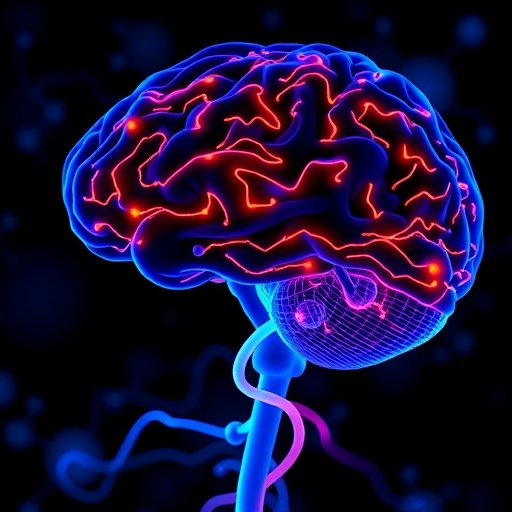In a groundbreaking study that promises to reshape our understanding of neurodegenerative diseases, Zhao et al. (2025) delve deep into the complex interplay between mitochondrial dysfunction, neurotoxicity, and the potential protective role of nicotine. This research, published in the Journal of Translational Medicine, focuses on the mechanism by which GSDME-N, a known player in the realm of neurodegeneration, inflicts damage upon cellular mitochondria. The findings not only illuminate the pathological processes associated with early neurodegeneration but also highlight a potential therapeutic avenue involving nicotine—a substance often viewed through the lens of its addictive properties.
Mitochondria are well-known as the powerhouse of the cell, generating adenosine triphosphate (ATP) and regulating apoptosis. However, they play an equally crucial role in the health of neurons. Mitochondrial dysfunction has been implicated in various neurodegenerative diseases, including Alzheimer’s, Parkinson’s, and Huntington’s diseases. The current study elaborates on how GSDME-N induces mitochondrial neurotoxicity, presenting a critical puzzle piece in the mysterious landscape of early neurodegeneration. The research introduces compelling data on how the dysregulation of mitochondrial integrity contributes to cellular degeneration, outlining a pathway toward developing more effective interventions.
At the heart of this research is the molecule known as GSDME-N, which has garnered attention for its role in mediating neurotoxic effects. The authors meticulously document how GSDME-N accumulates in neural tissues and interacts with mitochondrial membranes, leading to detrimental consequences that promote early indicators of neurodegeneration. The cascade of pathological events initiated by GSDME-N underlines the urgent need to identify countermeasures that can rescue neuronal health before irreversible damage occurs.
Surprisingly, the study reveals an unexpected hero in nicotine, a compound often vilified in public health discussions. Zhao and colleagues have unearthed evidence suggesting that nicotine possesses the ability to enhance autophagic flux—a cellular process that cleanses damaged organelles, including defective mitochondria. This autophagy enhancement appears to mitigate the toxic effects of GSDME-N, indicating a potentially beneficial role for nicotine in neural health interventions. This finding challenges conventional views regarding nicotine, positioning it as a candidate for therapeutic exploration in neurodegenerative studies.
To substantiate their hypotheses, the researchers employed advanced techniques including live-cell imaging and biochemical assays to track mitochondrial activity and autophagic processes. The results were striking: nicotine treatment significantly reduced mitochondrial dysfunction and improved cell viability in models expressing GSDME-N. These findings establish a strong rationale for exploring nicotine-based therapies aimed at not only treating but preventing the onset of neurodegenerative conditions.
Moreover, this research grapples with the broader implications of nicotine on human health. While traditionally considered a recreational drug with a significant addiction potential, the emerging research narrative prompts a reevaluation of nicotine’s biological effects, particularly in the context of neuroprotection. The duality of nicotine’s properties invites a deeper dialogue about its risks and benefits, especially as an aging global population faces an increasing burden of neurodegenerative diseases.
The neuroprotective effects of nicotine may stem from its ability to modulate neuroinflammatory responses, in addition to enhancing autophagic activity. In an aging brain, exacerbated inflammation can dramatically worsen neurodegeneration. Zhao et al. posited that applying nicotine could, therefore, not only suppress neurotoxic factors like GSDME-N but also mitigate the chronic inflammatory conditions that undermine neuronal health. Their findings encourage further research into the molecular mechanisms by which nicotine can be harnessed for neuroprotective strategies.
As the scientific community grapples with the alarming rates of neurodegenerative diseases, studies like this shine a crucial light on potential avenues for intervention. The concept that a widely stigmatized compound may harbor therapeutic benefits opens up a new frontier in neuroscience and medicine. However, this multifaceted approach requires careful evaluation; future studies must rigorously address the implications of long-term nicotine use in varied demographics, especially among those already susceptible to addiction.
Importantly, the research emphasizes the need for multi-targeted therapeutic strategies to combat the underlying mechanisms of neurodegeneration. Relying solely on a single agent, such as nicotine, may not suffice to achieve optimal neuroprotection. Instead, combining nicotine with other pharmacological agents that bolster mitochondrial health and enhance overall cellular viability represents a promising frontier in therapeutic development.
In summary, Zhao et al. present compelling evidence to suggest that nicotine may enhance autophagic flux, thereby exerting a neuroprotective effect against the mitochondrial neurotoxicity induced by GSDME-N. Their findings underscore the importance of understanding the complex pathophysiology underlying early neurodegeneration and open up new avenues for potential therapeutic interventions. Given the global impact of neurodegenerative diseases, this research could herald a paradigm shift in how we conceptualize treatment options, challenging long-held beliefs about nicotine and its role in neurological health.
The implications of this research extend far beyond laboratory findings; they prompt critical discussions regarding public health policies and the potential repurposing of nicotine as a treatment option in the face of burgeoning neurodegenerative disorders. As further research ensues, the scientific community must diligently explore the therapeutic window that exists within the complex landscape of nicotine and neuroprotection.
This pioneering work contributes significant insights into mitochondrial dysfunction in neurodegeneration and presents a novel look at the potential therapeutic applications of nicotine in enhancing neuronal resilience. Future research efforts will be pivotal in validating these findings and exploring the safe implementation of nicotine-based therapies in clinical settings, ultimately driving forward the quest for effective treatments against some of humanity’s most daunting health challenges.
Subject of Research: Neurodegeneration, mitochondrial dysfunction, nicotine therapy
Article Title: GSDME-N-induced mitochondrial neurotoxicity in early neurodegeneration was suppressed by nicotine via enhancing autophagic flux
Article References: Zhao, J., Qiu, S., Guo, A. et al. GSDME-N-induced mitochondrial neurotoxicity in early neurodegeneration was suppressed by nicotine via enhancing autophagic flux. J Transl Med 23, 1202 (2025). https://doi.org/10.1186/s12967-025-07247-y
Image Credits: AI Generated
DOI: 10.1186/s12967-025-07247-y
Keywords: GSDME-N, mitochondrial neurotoxicity, nicotine, neurodegeneration, autophagic flux




